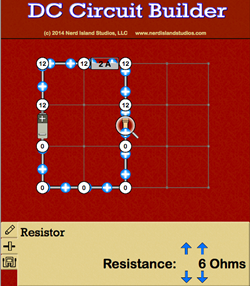 Voltage and Resistance
Voltage and Resistance
Resource:
Physics Interactives: Circuit Builder
Voltage, Current, and Resistance - Student Exercise
Grade Level: High School
Description:
This activity explores voltage-current-resistance relationships by blending an Interactive - DC Circuit Builder - with a student exercise explicitly designed to focus on the Ohm’s Law equation. The simulation alone helps students understand that the circuit must be
complete in order to transfer energy. When coupled with the Student Exercise, students will figure out the patterns that occur upon doubling or tripling battery voltage and resistance.
This activity aligns with the three dimensions of the Next Generation Science Standards in the manner described below:
| Definitions of Energy (HS-PS3.A.4): Electrical energy may mean energy stored in a battery or energy transmitted by electric currents. |
This circuit-building simulation provides a virtual electronic circuit board to explore how current flow is affected by voltage and resistance in a DC circuit. The student exercise provides a low-stress environment for students to build circuits, add resistors and batteries, measure voltage drops, and analyze circuit configurations without the time limits and pressures of a circuit lab. The Student Exercise introduces the mathematical relationships found in the Ohm’s Law equation. |
| Structure and Function: Investigating or designing new systems or structures requires a detailed examination of the properties of different materials, the structures of different components, and connections of components to reveal its function. |
This circuit simulator provides a very engaging way for students to explore structure-function relationships. Students must pay attention to how circuit components - wires, batteries, bulbs, resistors, etc. - must be connected to produce intended results. Students quickly recognize that it is the function of a battery to provide a voltage difference across a circuit and that it is the function of a resistor to hinder the flow of charge and reduce the amount of current. |
| Cause and Effect: Systems can be designed to cause a desired effect. |
This activity prompts students to think of “Cause and Effect” relationships in their circuit design. For example, “If I increase/decrease the voltage, what effect does this have on current flow?” The thrust of the student exercise is understanding the effect of a change in one variable upon another variable. |
| Using Mathematics and Computational Thinking: Use mathematical representations of phenomena to describe explanations. |
The DC Circuit Builder with accompanying Student Exercise focuses student efforts on developing an equation that relates voltage, current, and resistance. After collecting data and inspecting various cause-effect numerical relationships, students make an effort to develop and equation that fits the data. |
Associated Reading from The Physics Classroom
Other Supporting Pages at The Physics Classroom:
- The Curriculum Corner: Electric Potential Difference; Electric Circuits and Electric Current; and Electrical Resistance
View Infographic.
(Coming Soon)
Search the NGSS Corner
Maybe you're looking for something really specific that pertains to a desired topic and emphasizes one or more of the listed NGSS dimensions. Why not try a search of this section of our website? Simply select from one or more of the pull-down menus and click Search This page will reload and a collection of possibilities will be displayed in this section of the page and sorted by relevancy.